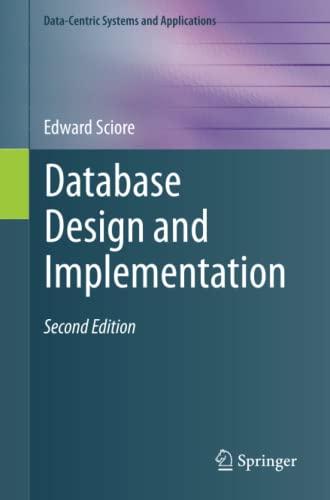Question
Attached below is the code of a program in C language: ******************************************************************************************************************************************************** /* * critical.c * * Demonstrate use of mutual exclusion using mutexes *
Attached below is the code of a program in C language:
********************************************************************************************************************************************************
/*
* critical.c
*
* Demonstrate use of mutual exclusion using mutexes
*
* Upper case output indicates critical output
* lower case output indicates non-critical output
*
* compile with
cc critical.c -o critical -lrt -lpthread
*
*/
#define _GNU_SOURCE
#define _REENTRANT /* macro to ensure system calls are reentrant */
#include
#include
#include
#include
#include
pthread_mutex_t mtx = PTHREAD_MUTEX_INITIALIZER; /*define mutex */
void *threadA(void *); /* predefine threadA routine */
void *threadB(void *); /* predefine threadB routine */
pthread_t threadA_id,threadB_id,main_id; /* thread identifiers */
pthread_attr_t attrA,attrB; /* thread attribute structures */
struct sched_param param; /* scheduling structure for thread attributes */
int policy=SCHED_FIFO;
int priority_min,priority_max; /* for range of priority levels */
/* main routine */
int main()
{
struct timespec start;
int status; /* check that system calls return ok */
clock_gettime(CLOCK_REALTIME, &start); /* get the time */
printf("Start time is: %d seconds %d nano_seconds ",start.tv_sec,start.tv_nsec);
/* Set processor affinity */
cpu_set_t mask; CPU_ZERO(&mask); CPU_SET(0,&mask); /* use only 1 CPU core */
unsigned int len = sizeof(mask);
status = sched_setaffinity(0, len, &mask);
if (status < 0) perror("sched_setaffinity");
status = sched_getaffinity(0, len, &mask);
if (status < 0) perror("sched_getaffinity");
/* Find priority limits */
priority_max = sched_get_priority_max(policy);
priority_min = sched_get_priority_min(policy);
/* Change priority and policy of main thread */
main_id = pthread_self();
param.sched_priority=priority_min;
status = pthread_setschedparam(main_id, policy, ¶m);
if (status != 0) perror("pthread_setschedparam"); /* error check */
/* Create threadA */
param.sched_priority = priority_min;
pthread_attr_init(&attrA);
status = pthread_attr_setschedpolicy(&attrA,policy);
if (status != 0) perror("pthread_attr_setschedpolicy"); /* error check */
status = pthread_attr_setschedparam(&attrA,¶m);
if (status != 0) perror("pthread_attr_setschedparam"); /* error check */
status = pthread_create(&threadA_id, &attrA, threadA, NULL);
if (status != 0) perror("pthread_create"); /* error check */
status = pthread_setschedparam(threadA_id,policy,¶m);
if (status != 0) perror("pthread_setschedparam");
/* Create threadB */
param.sched_priority = priority_min;
pthread_attr_init(&attrB);
status = pthread_attr_setschedpolicy(&attrB,policy);
if (status != 0) perror("pthread_attr_setschedpolicy"); /* error check */
status = pthread_attr_setschedparam(&attrB,¶m);
if (status != 0) perror("pthread_attr_setschedparam"); /* error check */
status = pthread_create(&threadB_id, &attrB, threadB, NULL);
if (status != 0) perror("pthread_create"); /* error check */
status = pthread_setschedparam(threadB_id,policy,¶m);
if (status != 0) perror("pthread_setschedparam");
/* Join threads - force main to wait for the thread to terminate */
printf("main() waiting for threads ");
status = pthread_join(threadA_id, NULL);
if (status != 0) perror("pthread_join(threadA_id, NULL)"); /* error check */
status = pthread_join(threadB_id, NULL);
if (status != 0) perror("pthread_join(threadB_id, NULL)"); /* error check */
printf(" main() reporting that all threads have terminated ");
status = pthread_mutex_destroy(&mtx); /* delete mutex */
if (status != 0) perror("pthread_mutex_destroy"); /* error check */
return(0);
} /* end of main */
void *threadA(void *arg)
{
int j;
int status; /* check that system calls return ok */
for(j=1;j<=5;j++){
printf("a"); /* non -critical */
}
/* lock to enter critical region */
/* status = pthread_mutex_lock(&mtx);
if (status != 0) perror("pthread_mutex_lock");*/ /* error check */
for(j=1;j<=5;j++){
printf("A"); /* critical */
}
/* increment priority of threadB above threadA */
param.sched_priority++;
status = pthread_setschedparam(threadB_id,policy,¶m);
if (status != 0) perror("pthread_setschedparam"); /* error check */
for(j=1;j<=5;j++){
printf("A"); /* critical */
}
/* unlock critical region */
/* status = pthread_mutex_unlock(&mtx);
if (status != 0) perror("pthread_mutex_unlock");*/ /* error check */
for(j=1;j<=5;j++){
printf("a"); /* non -critical */
}
return (NULL);
}
void *threadB(void *arg)
{
int j;
int status; /* check that system calls return ok */
for(j=1;j<=5;j++){
printf("b"); /* non -critical */
}
/* lock to enter critical region */
/* status = pthread_mutex_lock(&mtx);
if (status != 0) perror("pthread_mutex_lock");*/ /* error check */
for(j=1;j<=5;j++){
printf("B"); /* critical */
}
/* increment priority of threadA to above threadB*/
param.sched_priority++;
status = pthread_setschedparam(threadA_id,policy,¶m);
if (status != 0) perror("pthread_setschedparam"); /* error check */
for(j=1;j<=5;j++){
printf("B"); /* critical */
}
/* unlock critical region */
/* status = pthread_mutex_unlock(&mtx);
if (status != 0) perror("pthread_mutex_unlock");*/ /* error check */
for(j=1;j<=5;j++){
printf("b"); /* non -critical */
}
return (NULL);
}
********************************************************************************************************************************************************
Explain what this program does and how the scheduling gives rise to the observed behaviour in the output.
Give a timing diagram, and show the state of each task (including the main routine) at all times.
Step by Step Solution
There are 3 Steps involved in it
Step: 1

Get Instant Access to Expert-Tailored Solutions
See step-by-step solutions with expert insights and AI powered tools for academic success
Step: 2

Step: 3

Ace Your Homework with AI
Get the answers you need in no time with our AI-driven, step-by-step assistance
Get Started


